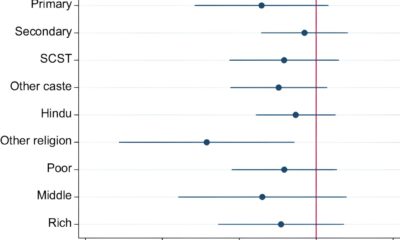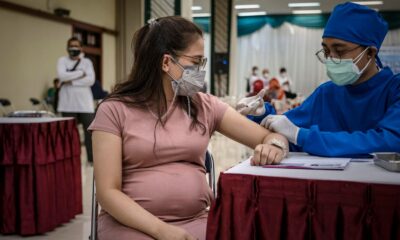Health
What toilet paper and game shows can teach us about the spread of epidemics

Credit: Su San Lee/Unsplash
How can we explain and predict human behavior? Are mathematics and probability up to the task, or are humans too complex and irrational?
People’s actions often surprise us, especially when they seem irrational. Take the COVID pandemic: something no one saw coming was a rush for toilet paper, leaving supermarket shelves empty in many countries.
But by combining ideas from mathematics, economics and behavioral sciences, researchers were eventually able to create mathematical models of it how panic spreads between peoplewhich made the toilet paper panic logical.
In new research published in the Journal of the Royal Society Interfacewe have taken a similar approach to the spread of disease – and shown that human responses to the spread of disease can be as important as the behavior of the disease itself when it comes to determining how an outbreak evolves.
The power of context
One thing we know: context can influence people’s behavior in surprising ways. A late-night example of this is the popular TV game show Deal or No Deal, in which participants regularly turn down offers of free money because they hope they will receive a larger amount later.
If you do a rational calculation of the probabilities, the participant’s “best” move is usually to accept the offer. But in practice, people often turn down a reasonable offer and continue to wait for a small chance at the big money.
Would someone turn down $5,000 if offered it in a different context? In this situation, simple mathematics cannot predict how people will behave.
The science of irrationality
What if we go beyond math? Behavioral science has a lot to say about what drives people to take specific actions.
In this case, this may indicate that people behave more reasonably when they set a realistic goal (such as getting $5,000) and place this goal in a powerful motivational context (such as planning to use the money to pay for a vacation) .
But time and time again, even people with clear, achievable goals get swept away by emotion and context. At the right time and place, they will believe they are lucky and refuse an offer of $5,000 in hopes of something bigger.
Nevertheless, researchers have found ways to understand this the behavior of Deal or No Deal participants by combining ideas from mathematics, economics and the study of behavior surrounding risky choices.
Essentially, the researchers found that participants’ decisions are “path dependent.” This means that their choice to accept a banking offer depends not only on their goal and the opportunities, but also on the choices they have already made.
Group behavior
Deal or No Deal is of course largely about individuals making decisions in a particular context. But when we try to understand the spread of disease, we are interested in how entire groups of people behave.
This is the domain of social psychology, where group behavior and attitudes can influence individual actions. In some ways this makes groups easier to predict, and this is where combining math and behavioral sciences really starts to yield results.
While some mass behaviors were highly visible early in the COVID pandemic – such as panic buying toilet paper – others were not. Mobility data from Google showed that people chose to restrict their own movement, for example, before mandatory restrictions were in place.
Feedback loops
Fear and perceived risk can promote self-preservation through positive crowd behavior. For example, as more diseases occur in the community, people are more likely to take action to avoid getting sick.
These actions, in turn, have a direct impact on the spread of the disease, which further influences human behavior and so on. Many mathematical models of how diseases spread have not taken this feedback loop into account.
Our new study is a step toward combining modeling of population disease spread with modeling of crowd behavior, aimed at understanding the links between behavior and infection.
Our framework takes into account dynamic and self-directed protective health behaviors in the presence of an infectious disease. This puts us in a better position to make informed choices and policy recommendations for future epidemics.
In particular, our approach allows us to understand how crowd behavior influences the large burden that the disease will impose on the population in the long term. There is still a lot of work to be done in this area.
To better understand human behavior from a mathematical perspective, we need better data on human choices in the presence of an infectious disease. This allows us to pick out patterns that can be used for predictions.
Predict behavior
So back to the question: can we predict human behavior? It depends. There are many factors that contribute to our choices: emotion, context, risk perception, social observation, fear, excitement.
Understanding which of these factors to investigate with mathematics is not an easy task. However, when society faces so many challenges related to changes in crowd behavior – from infectious diseases to climate change – using mathematics to describe and predict patterns is a powerful tool.
But no single discipline can provide the answer to global challenges that require changes in human behavior on a large scale. We will need more interdisciplinary teams to achieve meaningful impact.
More information:
Matthew Ryan et al., A Model of Behavior and Disease Transmission: Integrating the Health Belief Model of Human Behavior into a Simple Transmission Model, Journal of the Royal Society Interface (2024). DOI: 10.1098/rsif.2024.0038
This article is republished from The conversation under a Creative Commons license. Read the original article.![]()
Quote: What Toilet Paper and Game Shows Can Teach Us About the Spread of Epidemics (2024, June 6), retrieved June 6, 2024 from https://medicalxpress.com/news/2024-06-toilet-paper-game-epidemics.html
This document is copyrighted. Except for fair dealing purposes for the purpose of private study or research, no part may be reproduced without written permission. The content is provided for informational purposes only.













